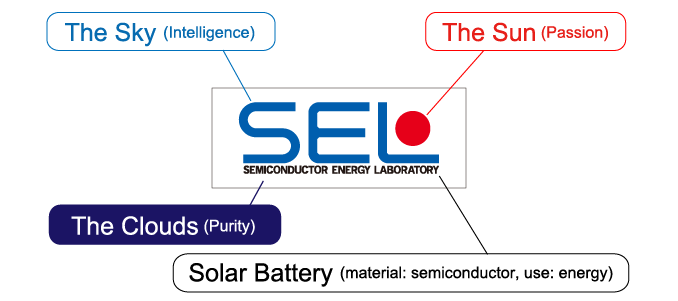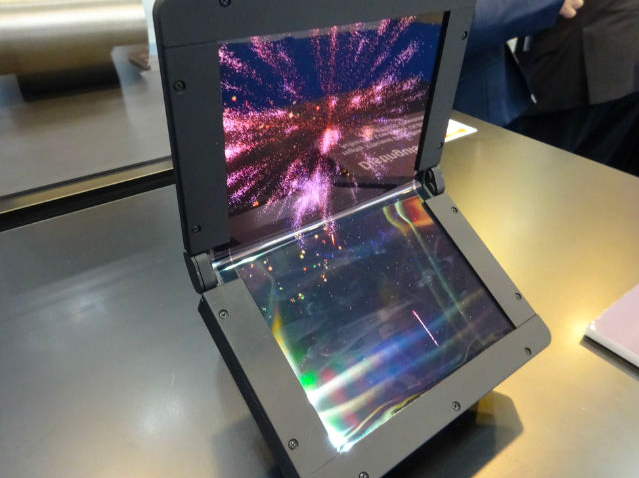New 8K OLED Displays for Tablets and Laptops: 8.3 and 13.3 Inches
by Anton Shilov on December 21, 2018 1:00 PM EST
Semiconductor Energy Laboratory, a technology developer from Japan, has developed the industry’s first 8.3 and 13.3-inch OLED displays featuring an 8K resolution. The monitors use crystalline oxide semiconductor technology and they are likely preliminary designs for future product commercialization. The company also recently showcased a bendable 8.6-inch OLED panel, potentially for a foldable tablet or smartphone.
| Size | Resolution | PPI | Refresh Rate |
Bendy |
| 8.3-inch | 7680 x 4320 | 1062 | 60 Hz | - |
| 13.3-inch | 7680 x 4320 | 663 | 120 Hz | - |
| 8.6-inch | 1900 x 1200 | 263 | 60 Hz | Yes |
Both of SEL’s OLED panels featuring a 7680×4320 resolution use a color filter that relies on CAAC-IGZO (c-axis aligned crystalline indium gallium zinc oxide) material. The 8.3-inch 8K panel can boast with a rather high pixel density of 1061 pixels per inch and has a refresh rate of 60 Hz. The larger 13.3-inch 8K panel features a pixel density of 662 PPI, but has a refresh rate of 120 Hz, which is particularly high for an OLED. The 8.3-inch 8Kp60 OLED was demonstrated last month at SEMICON Japan, whereas the 13.3-inch 8Kp120 OLED currently exists only in SEL’s labs.
The 8.3-inch display is 1062 PPI. For comparison, Sony's Z5 Premium with a 5.5-inch display and 4K resolution was 801 PPI. At 8.3-inches, it's a little big for a smartphone, so it will be interesting if that size can come down a little bit. 8K at 6.5-inches would be 1355 PPI, so the power draw would be quite interesting.
Other notable developments of SEL include a foldable 8.6-inch OLED panel with an 1920×1200 resolution rated for 10,000 bend/unbend cycles (that is 27.4 folds per day over a year) as well as OLED panels capable of displaying the BT.2020 color space.
The primary focus of Semiconductor Energy Laboratory’s work is development of crystalline oxide semiconductor technologies for various applications including chips and displays. CAAC-IGZO is recognized as one of next-generation materials that enable high-resolution low-power displays, so SEL is working on its practical implementations. Being an IP-licensing company, SEL does not have its own production capacities, so it will need a partner to make CAAC-IGZO-based 8K OLEDs a reality.
Related Reading
- Samsung Begins Sales of 65-Inch Q900R 8K UHDTV in the UK
- Samsung Starts to Take Pre-Orders on 85-Inch Q900 8K UHDTV
- Samsung’s One Invisible Connection: 75 Gbps and 230W in a Ultra Thin Cable
- Sharp’s 8K UHD TV Available in Japan, Listed in Europe for €11,899
- Sharp Announces 2nd Gen 8K UHD TVs at IFA
- AUO to Ship 8K UHD TV Panels in Coming Months
- Philips Demos 328P8K: 8K UHD LCD with Webcam, Docking, Coming in 2018
- Dell’s 32-inch 8K UP3218K Display Now For Sale: Check Your Wallet
Source: Optronics Online












59 Comments
View All Comments
Sergio526 - Friday, December 21, 2018 - link
Other than potentially better VR, I could see this also being used in digital gauge clusters for cars. People love to talk about the resolutions our eyes can see, but time and time again, cramming more details into the same space results in a noticeably more realistic image.emilemil1 - Saturday, December 22, 2018 - link
Gauges seems like one of the least necessary applications, since it's only something that needs to be readable at a glance from quite some distance away. No manufacturer is going to put ultra-high resolution panels into gauges to rack up costs at near zero benefit.ikjadoon - Sunday, December 23, 2018 - link
People absolutely care about car gauge resolution & clarity and manufacturers are listening. Rolls-Royce already uses 120Hz and/or low-persistence LCDs for the gauges in the 2019 Cullinan SUV. Technology trickles down...or are you still shopping for $1000 Blu-ray players?https://youtu.be/GSRAdaySmdU?t=152
"readable at a glance" = and the more life-like (i.e., crisp and clear), the easier it is to read
"Quite a distance away" = as cars become more technology-focused, screens become a differentiating factor and move closer to drivers (i.e., Tesla's).
Not to mention side-view cameras (Audi could've desperately used one of these screens with a higher peak brightness).
Gunbuster - Thursday, December 27, 2018 - link
Hope they make that panel easily accessible, last think you need is to tear a dashboard apart on a $100,000 car because the screen burned in on a static (but reconfigurable) display.Oxford Guy - Friday, December 28, 2018 - link
OLED is a horrible technology for a vehicle unless they make the parts easily replaceable, inexpensive, and available for a very very long time.It's far better to use a technology that has a longer lifespan for something like a car.
Oxford Guy - Friday, December 28, 2018 - link
"cramming more details into the same space results in a noticeably more realistic image"Only within the limitations of human visual acuity, which isn't much to write home about. The further away an object is, the lower the resolution can be with the same perceived fidelity. This is why 8K is totally unnecessary for HDTV.
crotach - Saturday, December 22, 2018 - link
I guess this resolution would make sense if the screens were glued to my face. Perhaps they will be used in some form of VR or glasses?Penti - Saturday, December 22, 2018 - link
They only really work with Sharp as far as I know (on IGZO) and Sharp already use CAAC-IGZO of course. Not sure if JDI has began to take steps to produce IGZO-displays yet. It's really only Foxconn's Sharp that could commercialize OLED with IGZO TFT's (besides LG) in the near future and maybe JDI/JOLED if they license the tech, no other manufacturers has a strong connection with Japan. Sharp's only OLED production is on plastic substrates I think though. LG's large OLED panels already uses IGZO though, but I haven't seen a connection between them and SEL.peevee - Sunday, December 23, 2018 - link
Insane. WAAAY beyond useless, it is actually detrimental to both performance and battery life. Too many stupid people in the market making things worse for the rest...aenews - Wednesday, December 26, 2018 - link
Blatantly false. Perhaps the technology is not that useful for you, but it's quite amazing for some others. I understand that people who really care about high resolutions are in the minority, but there's certainly a market for these displays. I want one. Now.